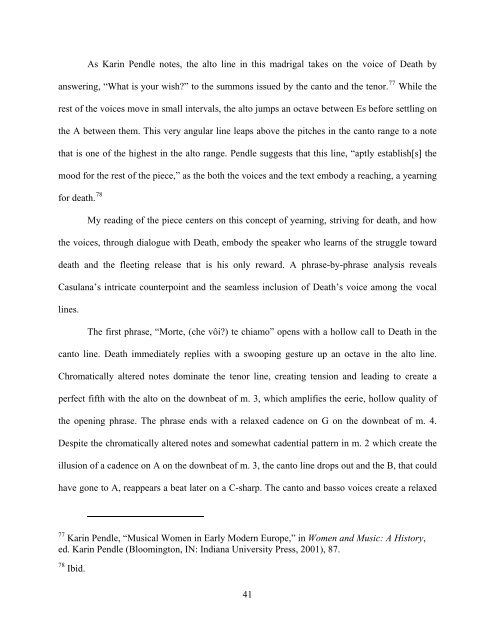Download - D-Scholarship@Pitt - University of Pittsburgh
Download - D-Scholarship@Pitt - University of Pittsburgh
Download - D-Scholarship@Pitt - University of Pittsburgh
Create successful ePaper yourself
Turn your PDF publications into a flip-book with our unique Google optimized e-Paper software.
As Karin Pendle notes, the alto line in this madrigal takes on the voice <strong>of</strong> Death by<br />
answering, “What is your wish?” to the summons issued by the canto and the tenor. 77 While the<br />
rest <strong>of</strong> the voices move in small intervals, the alto jumps an octave between Es before settling on<br />
the A between them. This very angular line leaps above the pitches in the canto range to a note<br />
that is one <strong>of</strong> the highest in the alto range. Pendle suggests that this line, “aptly establish[s] the<br />
mood for the rest <strong>of</strong> the piece,” as the both the voices and the text embody a reaching, a yearning<br />
for death. 78<br />
My reading <strong>of</strong> the piece centers on this concept <strong>of</strong> yearning, striving for death, and how<br />
the voices, through dialogue with Death, embody the speaker who learns <strong>of</strong> the struggle toward<br />
death and the fleeting release that is his only reward. A phrase-by-phrase analysis reveals<br />
Casulana’s intricate counterpoint and the seamless inclusion <strong>of</strong> Death’s voice among the vocal<br />
lines.<br />
The first phrase, “Morte, (che vôi?) te chiamo” opens with a hollow call to Death in the<br />
canto line. Death immediately replies with a swooping gesture up an octave in the alto line.<br />
Chromatically altered notes dominate the tenor line, creating tension and leading to create a<br />
perfect fifth with the alto on the downbeat <strong>of</strong> m. 3, which amplifies the eerie, hollow quality <strong>of</strong><br />
the opening phrase. The phrase ends with a relaxed cadence on G on the downbeat <strong>of</strong> m. 4.<br />
Despite the chromatically altered notes and somewhat cadential pattern in m. 2 which create the<br />
illusion <strong>of</strong> a cadence on A on the downbeat <strong>of</strong> m. 3, the canto line drops out and the B, that could<br />
have gone to A, reappears a beat later on a C-sharp. The canto and basso voices create a relaxed<br />
77 Karin Pendle, “Musical Women in Early Modern Europe,” in Women and Music: A History,<br />
ed. Karin Pendle (Bloomington, IN: Indiana <strong>University</strong> Press, 2001), 87.<br />
78 Ibid.<br />
41















